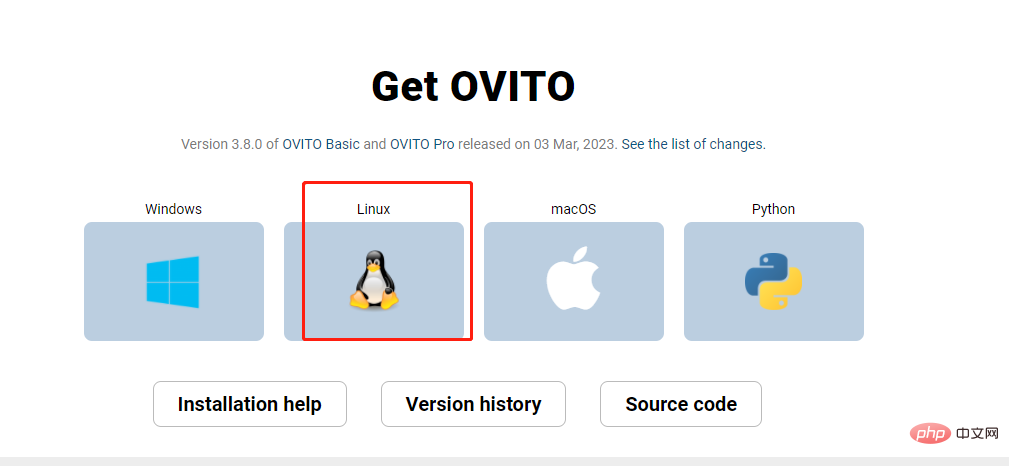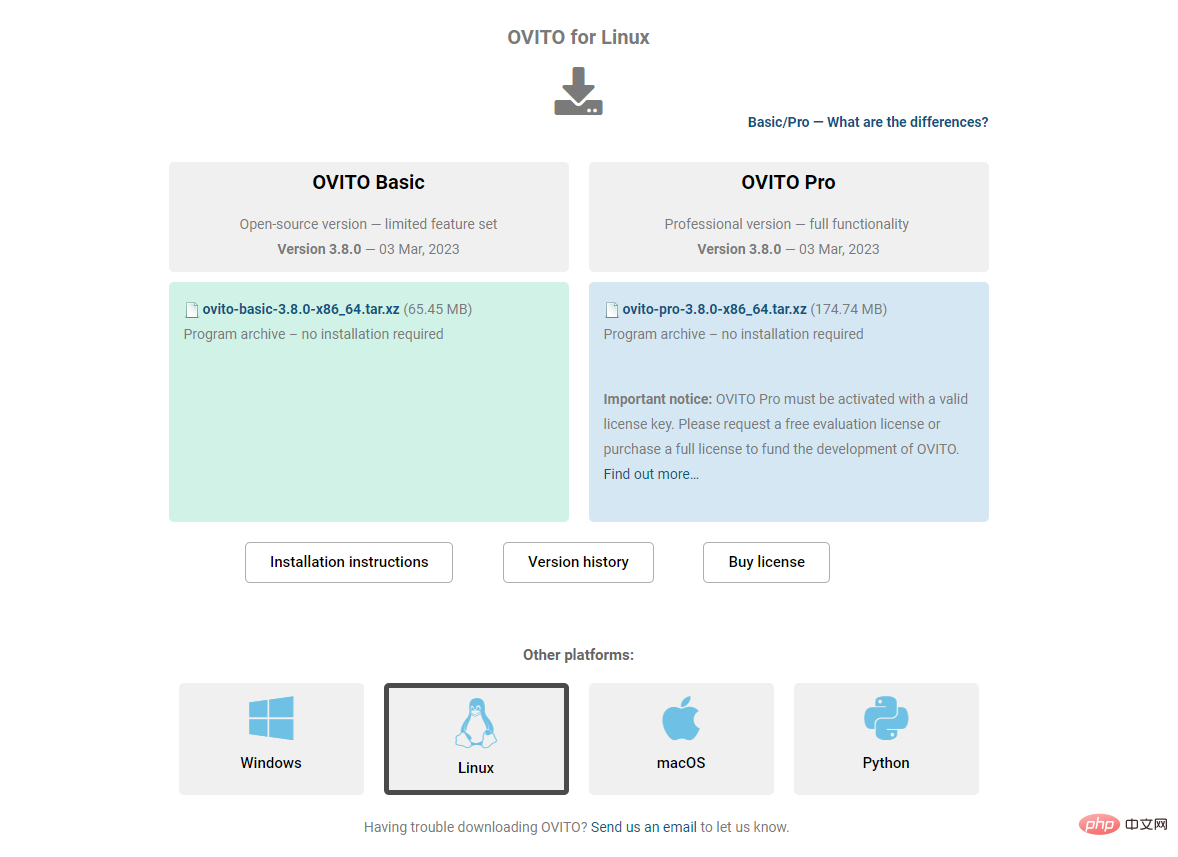 Operation and Maintenance
Operation and Maintenance
 Linux Operation and Maintenance
Linux Operation and Maintenance
 Does ovito have an installation package for Linux systems?
Does ovito have an installation package for Linux systems?
Does ovito have an installation package for Linux systems?
ovito has an installation package for Linux systems. OVITO is a scientific visualization and analysis software for atomic and particle simulation data. The program is available for free on all major platforms under an open source license, supporting major platforms such as Windows, Linux, macOS, etc. How to install ovito under Linux: 1. Download the compressed package of the Linux version from the official website; 2. Use the tar command to decompress it; 3. Use the export command to set environment variables.

#The operating environment of this tutorial: linux7.3 system, Dell G3 computer.
OVITO is a scientific visualization and analysis software for atomic and particle simulation data. It helps scientists better understand material phenomena and physical processes. The program is available for free on all major platforms (Windows, Linux, macOS, etc.) under an open source license. As a powerful tool for analyzing, understanding, and explaining simulation results, it has played a role in an increasing number of computational simulation studies.
ovito has an installation package for Linux systems. Official website download https://www.ovito.org/


##Installing ovito under linux
1. Download the linux version of the compressed package from the official website 2. Unzip ittar zxvf ovito-2.9.0-x86_64.tar.gz cd ovito-2.9.0-x86_64
export OVITO_HOME=/path/to/ovito-2.9.0-x86_64 export PATH=$OVITO_HOME/bin:$PATH
Please Change /path/to/ovito-2.9.0-x86_64 to the actual path after decompression.Enter
which ovito
ovito
export OVITO_HOME=/path/to/ovito-2.9.0-x86_64 cp libstdc++.so.6 $OVITO_HOME/lib/ovito cp libstdc++.so.6.0.21 $OVITO_HOME/lib/ovito
ovito
If the Linux environment does not support the graphical interface well, we can use the ovitos command to perform image processing on the command line.
Error: nivida library is missing
When running the ovitos command on the computing node, it is prompted that the libnvidia-tls.so and libnvidia-glcore.so libraries are missing. This library is in nvidia's driver library. We download it from the official website: Portal (opens new window). Select: Linux - x86_64 - RHEL - 6 - rpm(local) and download the cuda-repo-rhel6-7-5-local-7.5-18.x86_64.rpm compressed package. Then unzip the rpm package and find these two librariesrpm2cpio cuda-repo-rhel6-7-5-local-7.5-18.x86_64.rpm | cpio -div cd var/cuda-repo-7-5-local rpm2cpio xorg-x11-drv-nvidia-libs-352.39-1.el6.x86_64.rpm | cpio -div rpm2cpio xorg-x11-drv-nvidia-gl-352.39-1.el6.x86_64.rpm | cpio -div cd usr/lib64/nvidia
export LD_LIBRARY_PATH=/path/to/nvidia-lib:$LD_LIBRARY_PATH
Linux Video Tutorial"
The above is the detailed content of Does ovito have an installation package for Linux systems?. For more information, please follow other related articles on the PHP Chinese website!

Hot AI Tools

Undresser.AI Undress
AI-powered app for creating realistic nude photos

AI Clothes Remover
Online AI tool for removing clothes from photos.

Undress AI Tool
Undress images for free

Clothoff.io
AI clothes remover

Video Face Swap
Swap faces in any video effortlessly with our completely free AI face swap tool!

Hot Article

Hot Tools

Notepad++7.3.1
Easy-to-use and free code editor

SublimeText3 Chinese version
Chinese version, very easy to use

Zend Studio 13.0.1
Powerful PHP integrated development environment

Dreamweaver CS6
Visual web development tools

SublimeText3 Mac version
God-level code editing software (SublimeText3)

Hot Topics
 What computer configuration is required for vscode
Apr 15, 2025 pm 09:48 PM
What computer configuration is required for vscode
Apr 15, 2025 pm 09:48 PM
VS Code system requirements: Operating system: Windows 10 and above, macOS 10.12 and above, Linux distribution processor: minimum 1.6 GHz, recommended 2.0 GHz and above memory: minimum 512 MB, recommended 4 GB and above storage space: minimum 250 MB, recommended 1 GB and above other requirements: stable network connection, Xorg/Wayland (Linux)
 Linux Architecture: Unveiling the 5 Basic Components
Apr 20, 2025 am 12:04 AM
Linux Architecture: Unveiling the 5 Basic Components
Apr 20, 2025 am 12:04 AM
The five basic components of the Linux system are: 1. Kernel, 2. System library, 3. System utilities, 4. Graphical user interface, 5. Applications. The kernel manages hardware resources, the system library provides precompiled functions, system utilities are used for system management, the GUI provides visual interaction, and applications use these components to implement functions.
 vscode terminal usage tutorial
Apr 15, 2025 pm 10:09 PM
vscode terminal usage tutorial
Apr 15, 2025 pm 10:09 PM
vscode built-in terminal is a development tool that allows running commands and scripts within the editor to simplify the development process. How to use vscode terminal: Open the terminal with the shortcut key (Ctrl/Cmd). Enter a command or run the script. Use hotkeys (such as Ctrl L to clear the terminal). Change the working directory (such as the cd command). Advanced features include debug mode, automatic code snippet completion, and interactive command history.
 How to check the warehouse address of git
Apr 17, 2025 pm 01:54 PM
How to check the warehouse address of git
Apr 17, 2025 pm 01:54 PM
To view the Git repository address, perform the following steps: 1. Open the command line and navigate to the repository directory; 2. Run the "git remote -v" command; 3. View the repository name in the output and its corresponding address.
 Where to write code in vscode
Apr 15, 2025 pm 09:54 PM
Where to write code in vscode
Apr 15, 2025 pm 09:54 PM
Writing code in Visual Studio Code (VSCode) is simple and easy to use. Just install VSCode, create a project, select a language, create a file, write code, save and run it. The advantages of VSCode include cross-platform, free and open source, powerful features, rich extensions, and lightweight and fast.
 How to run java code in notepad
Apr 16, 2025 pm 07:39 PM
How to run java code in notepad
Apr 16, 2025 pm 07:39 PM
Although Notepad cannot run Java code directly, it can be achieved by using other tools: using the command line compiler (javac) to generate a bytecode file (filename.class). Use the Java interpreter (java) to interpret bytecode, execute the code, and output the result.
 What is the main purpose of Linux?
Apr 16, 2025 am 12:19 AM
What is the main purpose of Linux?
Apr 16, 2025 am 12:19 AM
The main uses of Linux include: 1. Server operating system, 2. Embedded system, 3. Desktop operating system, 4. Development and testing environment. Linux excels in these areas, providing stability, security and efficient development tools.
 How to run sublime after writing the code
Apr 16, 2025 am 08:51 AM
How to run sublime after writing the code
Apr 16, 2025 am 08:51 AM
There are six ways to run code in Sublime: through hotkeys, menus, build systems, command lines, set default build systems, and custom build commands, and run individual files/projects by right-clicking on projects/files. The build system availability depends on the installation of Sublime Text.





